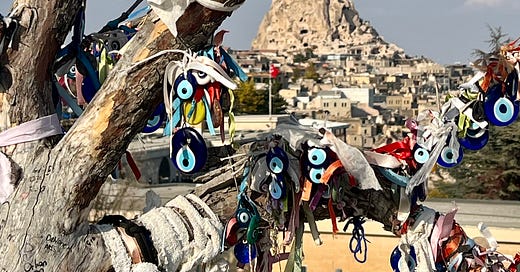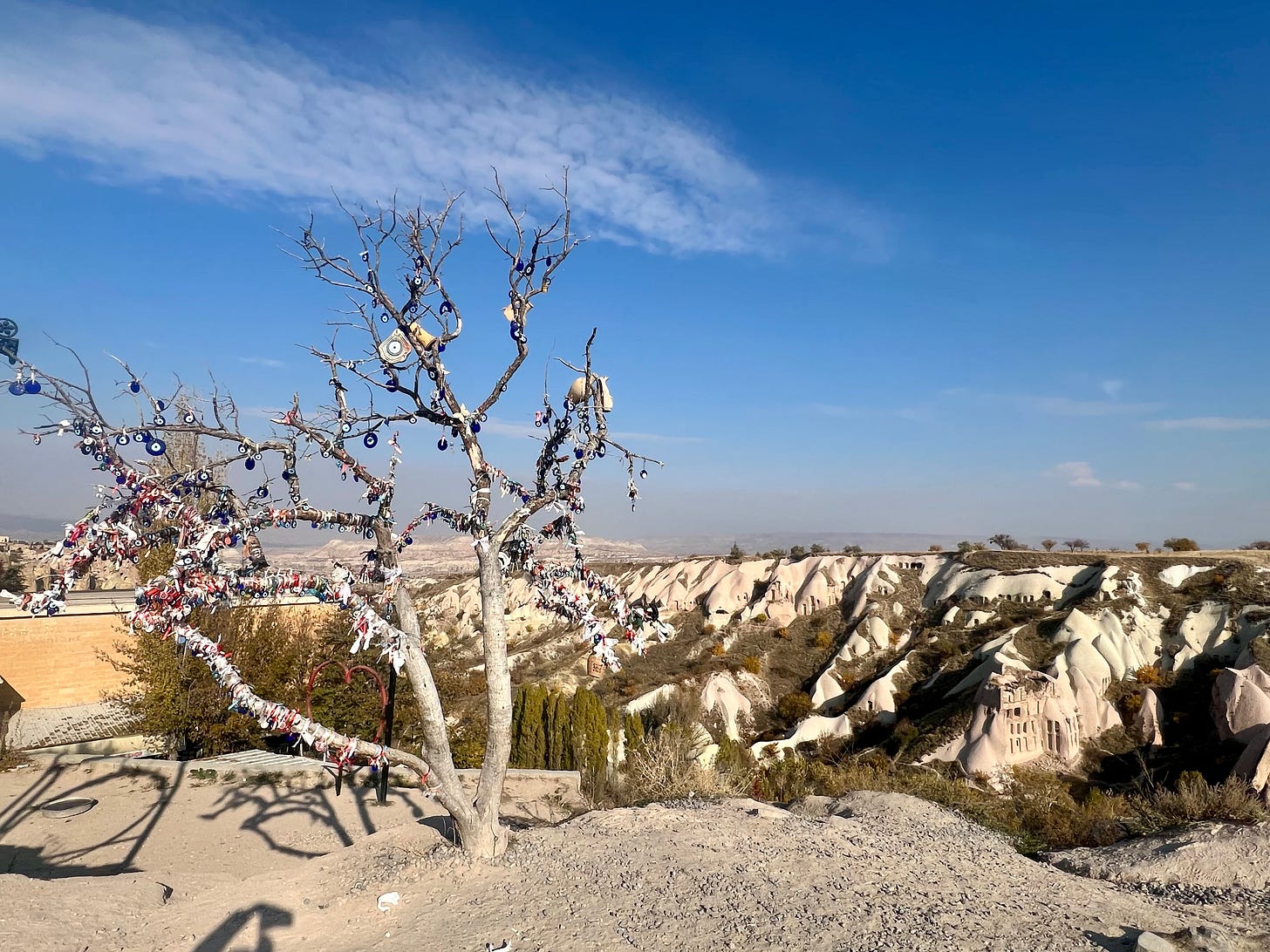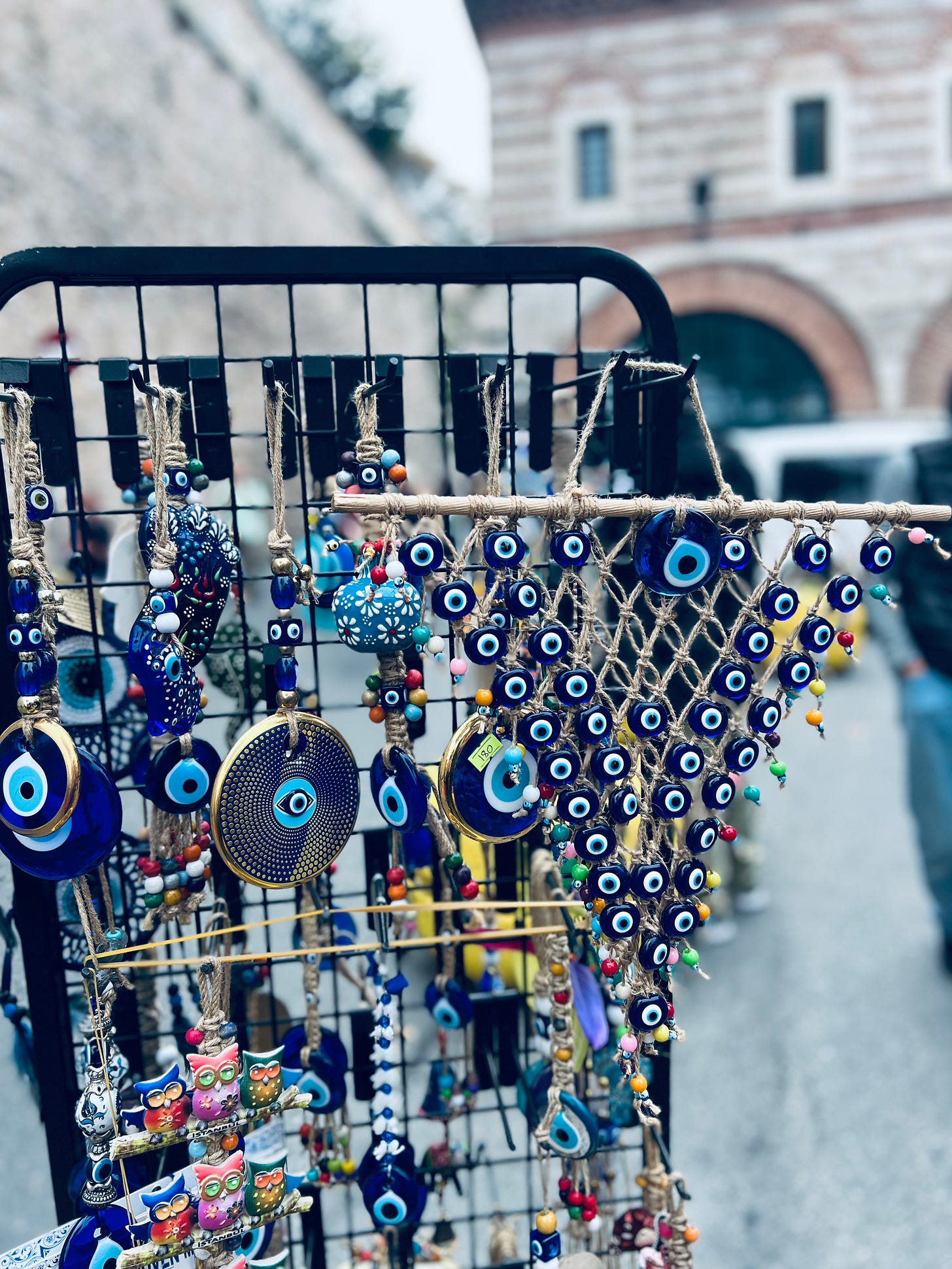13: Evil eyes, they’re watching me
Maybe a Turkish talisman can ward off bad times back in the U.S.?

My evil eye bracelet broke the afternoon of the U.S. presidential election. A dear friend had brought the plastic fantastic stretchy thing back from a trip to Uzbekistan. I’d worn the ring of blue and white orbs whenever I left the house during the COVID-19 lockdowns, an amulet against viruses, the noxious breath of other people, disturbing U.S. politics.
I’m not a slavish believer in talismans, but the thing had served me well through a global epidemic and some bumpy years. But on November 4th, the elastic filament inside the beads snapped as I slipped the bracelet on, leaving a small pile of nickel-sized eyeballs peering up from my dresser. I went to the office sans bling in my Harris Walz tee and black blazer.
The bracelet can be restrung, of course. (All roads somehow lead back to the jewelry supply aisle at Michaels.) But the timing was off. I was boarding a night flight to Istanbul on November 5, and after the depressing election results that morning, my busted lucky charm seemed ominous. Had I accidentally caused American democracy to fall by putting on my stack of arm candy?
On the ground in cloudy, chilly Istanbul for a writers’ conference, I strolled the cobblestones of the historic Sultanahmet district, zigzagging toward the Grand Bazaar and its warren of shops and hawkers. In business since around 1455, these days, the immense covered market holds more fake designer handbag dealers than magic carpet shops. Young Turks, 99 percent men, stand in front of their stalls smoking, gently admonishing passersby to come in, have some tea, and buy.
But every third stall twinkles with unblinking Mediterranean glass blue eyes. They range from dinner plate-sized orbs dangling from awnings to macrame wall hangings festooned with a half dozen eyeballs the diameter of quarters. There are ceramic spoon rests painted with dozens of eyes (“Away, bad tasting soup!”), evil eye beach bags (“Scram, rain!”), and even a round ashtray in brilliant blue with a white pupil at its center (“Begone, lung cancer?”)
“If you break an evil eye, it just means it’s doing the job protecting you. It took the hit for you.” —Antonio Pagliarulo, author and talisman expert.
Technically known as nazars, evil eyes are meant to repel the negative emotions other people might cast your way—envy, spite, bitterness. “The actual evil eye—or il malocchio—is a baneful glance that can cause bad luck to erupt,” said Antonio Pagliarulo, author of The Evil Eye: The History, Mystery & Magic of the Quiet Curse. “Nazars are the amulets used against the evil eye. They protect you by deflecting the bad energy.”
Eye charms might be most prevalent—or best marketed—in Turkey. There are even woe-specific nazars there: an evil eye shaped like an owl to bring wisdom, a fish-shaped one for luck or fertility. But many cultures have used similar ocular symbols for thousands of years.
Last year when I traveled around Egypt, I kept spotting the Eye of Horus on ancient temple walls and pendants in gold shops. The heavily lined eye represents healing and redemption, and stems from the story of the falcon god Horus, who lost and regained an eye.
In Mexico and New Mexico, ojos de dios (God’s eyes) are diamond-shaped weavings executed on crisscrossed sticks, signifying prayers for thriving children, good crops, and other blessings. I remember making them from toothpicks and colored yarn in Sunday school as a Southwestern kid; one still hangs on my holiday tree every year.
Jet-lagged and dragged down by the election results, I didn’t buy any evil eyes in Istanbul. But the symbols followed me on a weekend side trip to Cappadocia, the Anatolian region known for surreal, Dali-esque rock formations. Early Christians and others carved churches and cave homes into the zone’s sandstone chimneys and mountains, creating a landscape out of a sci-fi epic or a fever dream.
Overlooking Cappadocia’s stone valleys pockmarked with ancient caves, residents have covered a few dead trees with hundreds of evil eyes. From a distance, the trees seem to bloom with exotic flowers. Come closer, and you’ll spot tourists lined up to take selfies and hear the eyes clicking in the wind.
It’s hard not to feel comforted by the sheer number of protective talismans hanging from their branches. The evil eye trees become optimistic, “take that troubles!” shrines, even in Turkey, where the political turmoil and oppressive government serve as chilly warnings for America.
“It’s human nature to want to explain things, to feel like something in the sky or in the air wants to help you,” said Bunyamin Ozmen, my tour guide in Cappadocia. “The evil eye does that. It transcends religion and time and becomes universal.”
At a market in Göreme, one of Cappadocia’s prettiest towns, I spotted a rack covered in nazar bracelets in blues, greens, even yellows. The pea-sized glass beads were tightly strung, and seemed ready for battle. I picked up a few for myself and friends. Maybe I’ll wear one with my old eye bracelet, once I’ve put it back together.
“But I wouldn’t worry about damaging that bracelet,” said Pagliarula. “If you break an evil eye, it just means it’s doing the job protecting you. It took the hit for you!”










